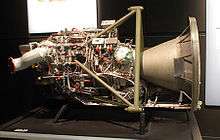S5.4
|
Vostok spacecraft replica at the Technik Museum Speyer, Germany. The lower conical section was the service module with the S5.4/TDU-1 engine. | |
| Country of origin | USSR |
|---|---|
| Date | 1959-1961 |
| First flight | 1959 |
| Designer | OKB-2, A.M. Isaev |
| Application | Spacecraft breaking engine |
| Successor | S5.35 |
| Status | Retired |
| Liquid-fuel engine | |
| Propellant | AK20F / TG-02 |
| Mixture ratio | 3.07 |
| Cycle | Gas Generator |
| Configuration | |
| Chamber | 1 main + 4 vernier |
| Performance | |
| Thrust (vac.) | 15.83 kilonewtons (3,560 lbf) |
| Chamber pressure | 5.6 megapascals (810 psi) |
| Isp (vac.) | 266 seconds |
| Burn time | 45 seconds |
| Propellant capacity | 250 kilograms (550 lb) |
| Dimensions | |
| Length | 1.13 metres (44 in) |
| Diameter | 0.95 metres (37 in) |
| Dry weight | 98 kilograms (216 lb) |
| Used in | |
| Vostok, Voskhod and Zenit | |
| References | |
| References | [1][2][3] |
The S5.4 (AKA TDU-1, GRAU Index 8D66), was a Russian liquid rocket engine burning TG-02 and AK20F in the gas generator cycle. It was originally used as the braking (deorbit) engine of the Vostok, Voskhod, and Zenit spacecraft, which later switched to solid engines.
The engine produced 15.83 kilonewtons (3,560 lbf) of thrust with a specific impulse of 266 seconds in vacuum, and burned for 45 seconds, enough for the deorbit. It had a main fixed combustion chamber and four small verniers to supply vector control. It was housed in the service module and had two toroidal tanks for pressurization.[4][5][6]
It was designed by OKB-2, the Design Bureau led by Aleksei Isaev, for the Vostok program. The braking engine for the first manned spacecraft was a difficult task that no design bureau wanted to take. It was considered critical, as a failure would have left a cosmonaut stranded in space. A solid engine was considered, but the ballistic experts predicted a 500-kilometer (270-nautical-mile) landing error, versus a tenth of that for a liquid engine. It took the coordinated efforts of Boris Chertok and Sergei Korolev to convince Isaev to accept the task.[7]
References
- ↑ Brügge, Norbert. "Spacecraft-propulsion blocks (KDU) from Isayev's design bureau (now Khimmash)". B14643.de. Retrieved 2015-06-02.
- ↑ "S5.4". Encyclopedia Astronautica. Retrieved 2015-07-25.
- ↑ Pillet, Nicolas. "Le vaisseau Vostok" [The Vostk spacecraft] (in French). Kosmonavtika.com. Retrieved 2015-07-25.
- ↑ Zak, Anatoly. "Origin of the Vostok spacecraft". RussianSpaceWeb. Retrieved 2015-07-25.
- ↑ LePage, Andrew J. "Vostok: an aerospace classic". The Space Review. Retrieved 2015-07-15.
- ↑ Turner, Martin J. L. (2008). "Section 9.2 — Crewed launchers and re-entry vehicles". Rocket and Spacecraft Propulsion: Principles, Practice and New Developments. Springer Science & Business Media. p. 314. ISBN 978-3540692034. Retrieved 2015-07-15.
- ↑ Chertok, Boris (May 2009). "Chapter 2 — Preparation for Piloted Flights". Rockets and People Vol. 3 — Hot Days of the Cold War (PDF). Volume 3 (NASA SP-2006-4110). NASA. p. 26. ISBN 978-0-16-081733-5. Retrieved 2015-07-15.

